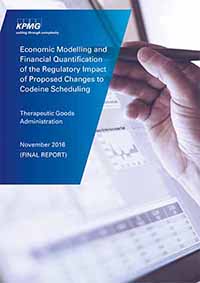We will have limited operations from 15:00 Wednesday 24 December 2025 (AEDT) until Friday 2 January 2026. Find out how to contact us during the holiday period.

Inherent limitations
This report has been prepared as outlined in the Background section. The services provided in connection with this engagement comprise an advisory engagement, which is not subject to assurance or other standards issued by the Australian Auditing and Assurance Standards Board and, consequently no opinions or conclusions intended to convey assurance have been expressed.
No warranty of completeness, accuracy or reliability is given in relation to the statements and representations made by, and the information and documentation provided by the Therapeutic Goods Administration management and personnel consulted as part of the process.
KPMG have indicated within this report the sources of the information provided. We have not sought to independently verify those sources unless otherwise noted within the report.
KPMG is under no obligation in any circumstance to update this report, in either oral or written form, for events occurring after the report has been issued in final form.
The findings in this report have been formed on the above basis.
Third party reliance
This report is solely for the purpose set out in the Background section and for the Therapeutic Goods Administration, and is not to be used for any other purpose or distributed to any other party (with the exception of providing the report for review by the Office of Best Practice Regulation in the Department of the Prime Minister and Cabinet) without KPMG's prior written consent.
This report has been prepared at the request of the Therapeutic Goods Administration in accordance with their Official Order for 'The provision of economic modelling and financial quantification of the regulatory, social and economic impacts of the proposed regulatory options for the rescheduling of codeine as outlined in the Department of Health request for quote and statement of requirements and with the response provided by KPMG' dated 02 August 2016. Other than our responsibility to the Therapeutic Goods Administration, neither KPMG nor any member or employee of KPMG undertakes responsibility arising in any way from reliance placed by a third party on this report. Any reliance placed is that party's sole responsibility.
© 2016 KPMG, an Australian partnership and a member firm of the KPMG network of independent member firms affiliated with KPMG International Cooperative ("KPMG International"), a Swiss entity. All rights reserved. The KPMG name, logo and "cutting through complexity" are registered trademarks or trademarks of KPMG International. Liability limited by a scheme approved under Professional Standards Legislation.

